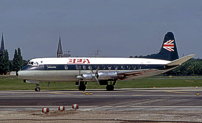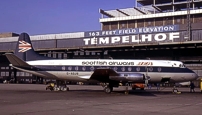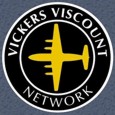
March 1956 to July 1973
British European Airways Corporation (BEA)
G-AOJB - c/n 151 - a V.802 series Viscount
United Kingdom registered
6 March 1956
Re-registered to British European Airways Corporation (BEA) from G-AOHB.
Although the reason for this registration change is not known, it is likely to have been done to avoid conflict operationally with V.701 Viscount G-ANHB (C/N 62).
Production Aircraft No. 2 - the 2nd production V.800 series Viscount built,
was the 2nd V.800 Viscount fuselage assembled at Hurn, Bournemouth, Hampshire, England,
and the 2nd V.800 Viscount assembled at Weybridge, Surrey, England.
Production Order No. F02/802. Sales Order No. F02/63B. Stock Order No. F02/26B.
7 March 1956
Fuselage assembly commenced at Hurn Airport, Bournemouth, Hampshire, England.
April 1956
Fuselage transported by road from Hurn Airport, Bournemouth, Hampshire, England to Weybridge, Surrey, England.
5 May 1956
Fuselage to Erecting Shop 'E' at Weybridge, Surrey, England.
29 September 1956
First flight from Brooklands Airfield, Weybridge, Surrey, England.
It landed at Wisley Airfield, Surrey, England for fitting out and test flying.
4 February 1957
Certificate of Airworthiness (CofA) issued.
6 February 1957
Delivered to British European Airways (BEA) named as 'R M A Stephen Borough'.
2 March 1957
Noted at Blackbushe Airport, Hampshire, England due to a London Airport weather diversion.
13 March 1957
Noted at Blackbushe Airport, Hampshire, England carrying out ILS approaches.
18 January 1958
Noted at Blackbushe Airport, Hampshire, England carrying out ILS approaches.
28 February 1959
Noted at Blackbushe Airport, Hampshire, England carrying out ILS approaches.
March 1959
A new BEA 'Red Square' livery was adopted and aircraft were repainted during the early 1960s when they next went in for overhaul.
Sadly, after repainting, the aircraft no longer carried a name including the nameplate on the forward cabin bulkhead.
31 March 1959
BEA annual report quotes a total flying time of 4,252 hours.

BEA
‘Red Square‘ livery

BEA
‘Flying Union Jack‘ livery
23 April 1959
Noted at Gatwick Airport, Surrey, England carrying out multiple ILS approaches and overshoots.
15 December 1959
Noted at Blackbushe Airport, Hampshire, England due to a London Airport weather diversion.
1 April 1960
Noted at Blackbushe Airport, Hampshire, England due to a London Airport weather diversion.
17 September 1960
After landing at Jersey Airport, Channel Islands the nose undercarriage leg collapsed.
This resulted in curl damage to all four propellers and shockload damage to the four Rolls-Royce Dart RDa6 Mark 510 engines.
There were no reported injuries to the 71 passengers and 3 crew on board.
An investigation afterwards could find no fault with the undercarriage mechanical or hydraulic systems.
Repaired and returned to service.
24 June 1961
Noted at Gatwick Airport, Surrey, England due to a London Airport (Heathrow) weather diversion.
22 June 1965
Noted at Leeds / Bradford Airport, Yeadon, Yorkshire, England operating UK services on behalf of BKS Air Transport Ltd.
4 July 1967
Total time 22,796:24 hours and 16,480 total landings.
29 October 1968
Total time 25,646:01 hours and 19,258 total landings.
10 January 1970
Struck a snow plough while taxiing at Abbotsinch Airport, Glasgow, Scotland.
Repaired and returned to service.
31 March 1970
BEA annual report quotes an annual utilisation of 2,015 hours for the year March 1969 to March 1970.
This was the highest in that year for the BEA Viscount fleet.
The total flying time for this aircraft was 28,118 hours to this date.
circa May 1970
Repainted in the new BEA ‘Flying Union Jack‘ livery.
1971
The Chairman of BEA – British European Airways Corporation, Henry Marking, split BEA into several divisions as part of his ‘profit centre’ philosophy, with each division being responsible for it’s own financial performance. As a result the BEA – British European Airways Viscount V.802 fleet was split into two.
The ‘Scottish Airways' division had eight Viscounts based at Abbotsinch, Glasgow, Scotland. The ‘Channel Islands' division had twelve Viscounts with four being operated from Jersey Airport, five from Elmdon Airport, Birmingham, West Midlands, England and one from Guernsey Airport, Channel Islands. The remaining two aircraft of the ‘Channel Islands' fleet were used on a charter to GB Airways to operate the Gibraltar to Tangier, Morocco service, and to act as operational spares.
All aircraft had either ‘Scottish Airways’ or ‘Channel Islands’ titling applied to the upper fuselage. In practice to maintain operational flexibility there was considerable mixing of the aircraft. On one occasion in August 1971 two of the ‘Channel Islands’ Viscounts were on the ramp together at Sumburgh Airport, Shetland Islands, some 750 miles (1,250 km) from the Channel Islands.

BEA – British European Airways
‘Scottish Airways‘ livery
circa August 1971
G-AOJB was allocated to the ‘Scottish Airways’ division and had ‘Scottish Airways’ titles applied alongside ‘BEA’ titling on the upper fuselage.
1 November 1971
Flew the British European Airways Viscount service from Templehof Airport, Berlin, West Germany to Heathrow Airport, London, England via Langenhagen Airport, Hannover, West Germany as BE1351A, carrying ‘BEA Scottish Airways’ titles. It was flown by Captain P W Hargreaves.
A large batch of postal covers were flown on the aircraft and subsequently sold to the general public.
31 March 1972
BEA annual report quotes a total flying time of 31,881 hours.
This was the last year that individual aircraft flying hours were reported.
31 July 1973
Transferred to British Airways (BA) due to a corporate merger.
 FURTHER READING: Books about BEA - British European Airways FURTHER READING: Books about BEA - British European Airways
|



